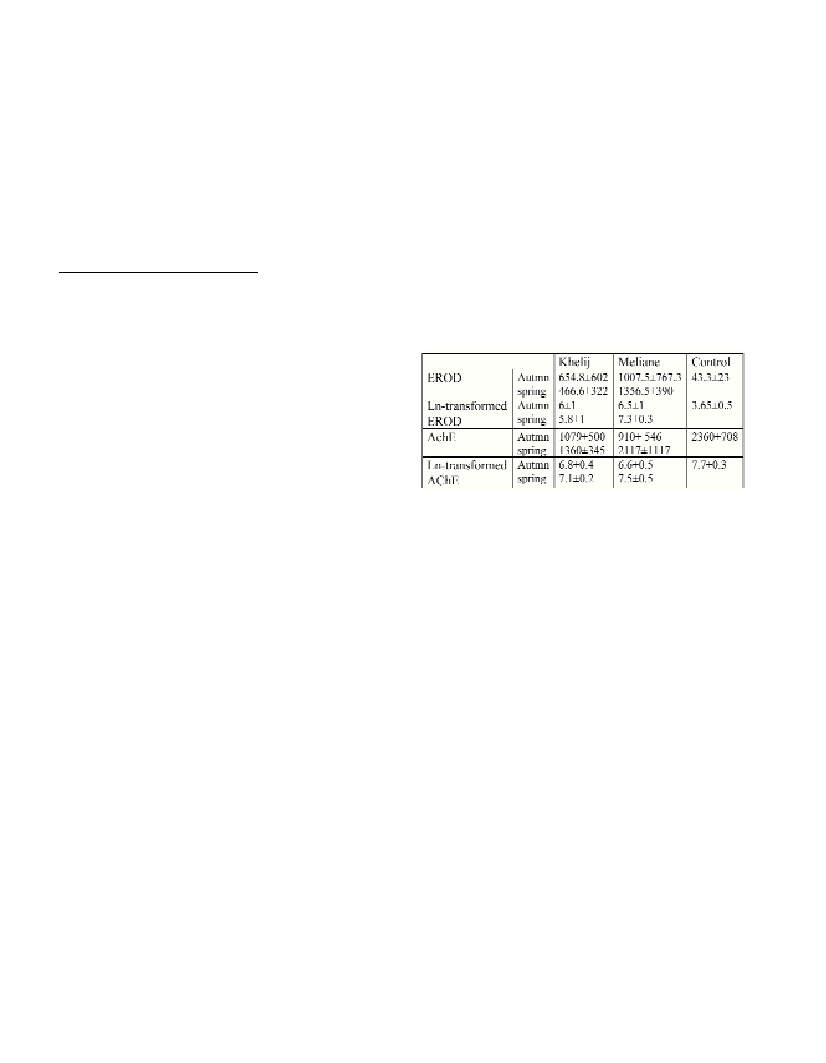Rapp. Comm. int. Mer Médit., 37,2004
221
CYTOCHROME P450 RESPONSES AND ACETYLCHOLINESTERASE ACTIVITY
IN THE GOLDEN GREY MULLET LIZA AURATAFOR EVALUATING URBAN EFFLUENTS EFFECTS
IN A COASTAL MARINE AREA : GULF OF TUNIS.
W. Masmoudi
1*
, Romdhane M.S.
2
, Khériji S.
1
and El Cafsi M.
1
1
Faculté des Sciences de Tunis, département des Sciences Biologiques, Laboratoire de physiologie animale, Campus universitaire,
1060 Tunis, Tunisie. * maswiem@lycos.com
2
Institut National Agronomique de Tunisie, Agrocampus, 43 av. Charles Nicolle 1082 Tunis, Tunisie
Abstract
Biomarkers measurements were investigated in juveniles of the golden grey mullet Liza auratasampled in autumn /Spring (2002/2003)
from two sites of Tunis gulf in order to asses the impact of two urban effluents “Khelij channel” and “Meliane wadi”. Results showed a
strong induction of EROD in fishes captured from both Khelij and Meliane outlets and they indicate probably a contamination by aromatic
and chlorinated hydrocarbons. Also a significant inhibition of acetylcholinesterase activity was demonstrated in fishes from the two sites
in autumn. We suspected then the presence of neurotoxic compounds as organophosphates and carbamates.
Keywords: Pollution, Biomarkers, Fish.
Introduction
The Biomarker constitute the biological reaction measurement
implied in the early intoxication steps. Among biochemical
biomarkers, the cytochromes P450 family is implied in oxidative
metabolism of xenobiotics such as aromatic and chlorinated
hydrocarbons. The measurement of EROD activity (ethoxyresorufin-
o-deethylase activity, a cytochrome P450 dependant monooxygenase)
in fish liver is widely validated in monitoring programs. The
acetylcholinesterase (AChE), enzyme implied in the
neurotransmission, is also considered as a useful biomarker since it’s
inhibited by organophosphorus and carbamate compounds. The aim
of the present study was to asses the quality of a coastal marine area
in Tunis gulf by measuring AChE and EROD activity in an euryhaline
fish, the golden grey mullet (Liza aurata), captured from mouths of
two channels, “Khelij” and “Meliane”, ?owing into the sea
Methodology
Juveniles of golden grey mullet (6-8 cm long) were caught around
the outlets of “Khelij” and “Meliane” channels during autumn/spring
(2002/2003). Liver and fragments of muscle are removed and kept in
liquid nitrogen for biomarkers analyses. EROD measurement was
performed in fish liver according to the French normalized method
[1]. AChE activity was determined in the muscle of fish according to
Ellman method [2]. Statistical analyses were performed withSatistica
software (StatSoft, USA). Data were log-transformed for achieving
normal distribution before running ANOVAs to determine statistical
differences among sampling sites and season.
Results
Results on EROD activity showed that this biomarkerwas
significantly elevated (p <0.05) in fishes caught in both Khelij and
Meliane outlets (Table 1) when compared to control fishes reared in
our laboratory (43.3 ±23 pmol/min/mg protein). These biomarkers
levels are probably linked to the presence of high levels of compounds
known to induce metabolic activity in fish livers as aromatic and
chlorinated hydrocarbons. We have already reported the presence of
an organochlorine pesticide, the lindane, in the sediment of Khelij
outlet [3]. EROD levels in the present study are higher than those
reported in the leaping mullet (Liza saliens) from a highly
contaminated bay of the Aegean sea (Izmir bay) exposed to
river/water contamination [4]. EROD values in control fishes are
similar to those registered in the grey mullet from a reference site in
the Orbetello lagoon, Italy [5]. A significant difference in EROD
activity between sites are registered in spring. In Fact, in this season,
the biomarker levels are higher in Meliane outlet than in Khelij site.
These results suggest that exposure to some xenobiotics varies
according to the different locations. And they re?ect the in?uence of
differential contamination levels on a short time scale.
Concerning AChE activity, we registered also a significant
inhibition of this enzyme (p<0.05) in the muscle of fishes from the
two sites in autumn and from Khelij outlet in spring in comparison to
the activity measured in reference fishes reared in the
laboratory(Table 1). Similar levels of reduction was already registered
in red mullet from Italian coastal marine area [6]. These data point out
the exposure of mullet fishes to anticholinesterase compounds. In fact,
the leaching of pesticides into the sea from agricultural land and the
discharge of urban wastewaters in these areas are responsible to this
contamination.
Table 1. Results of biomarkers measurements in golden grey mullet.
EROD activity is expressed as pmol/min/mg protein. AChE activity is
expressed as nmol/min/mg protein. Data are expressed as mean ±stan-
dard deviation
In conclusion, this work highlighted the first data about health
status of the gold mullet from Tunis gulf. These preliminary results
showed that the use of biomarkers in this fish species might re?ect the
early exposure to micropollutants. As we dispose a few information
about contaminant levels in this coastal area, a more detailed
investigation must be done.
References
1-Afnor, 2001. Méthode de mesure de l’activité enzymatique EROD chez
le poisson d’eaux douces et marines. Norme NF T 90-385, septembre
2001.
2-Ellman G.L., Courtney K.D., and Anders V., 1961. A new and rapid
colorimetric determination of acetylcholinesterase activity. Biochemical
pharmacology, 7 : 88-95.
3-Masmoudi W., Romdhane MS., Khériji S. and El Cafsi M., 2001.
Bioaccumulation of Lindane in wild larvae of Mugil cephalus, Liza aurata
and Liza ramada. MEDCOAST 01 Fifth International Conference on the
Mediterranean Coastal Environment; 23-27 October, Hammamet
(Tunisia)
4-Aeinç E., and Sen A., 1999. hepatic cytochrome P450 1A and 7-
ethoxyresorufin-o-deethylase induction in mullet and common sole as an
indicator of toxic organic pollution in Izmir Bay, Turkey. Mar. Env. Res.,
48:147-160.
5-Corsi I., Mariottini M., Sensini C., Lancini S., and Focardi S., 2003.
Cytochrome P450, acetylcholinesterase and gonadal histology for
evaluating contaminant exposur levels in fishes from a highly eutrophic
brackish ecosystem: the orbetello lagoon, Italy. Marine Pollution, 46:
203-212.
6-Lionetto M.G., Caricato R., Giordano M.E., Pascariello M.F,
Marinosci L., and Schettino T., 2003. Integrated use of biomarkers
(acetylcholinesterase and antioxidant enzymes activities) in Mytilus
galloprovincialisand Mullus barbatusin an Italian coastal marine area.
Marine Pollution Bulletin, 46: 324–330.

